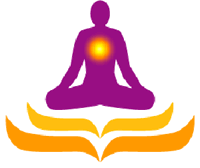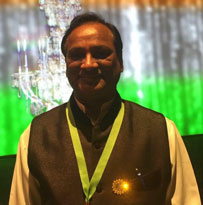Pranayam
‘Asan‘ are the technique of keeping our physical body sound and stable. A sound and healthy body is a’must’ for the practice of Pranayam. But for the correct understanding of Pranayam, it is necessary to have a workable knowledge of air, pran, the respiratory organs of the gross body, the different veins and arteries connected with our circulatory system as well as the main centers of Pran, where from life flows into the main organs of the body. We know that from our birth to death our breathing process continues unabated. But how little we know about it, can be any body’s guess.
 Breath and Pran are two different things altogether. But we cannot see them apart from each-other. Breath is Sthula (gross) and Pran is Suksham (subtle). It is the vital force. Breath is the external manifestation of Pran. Pran permeates everything and everywhere. It is through the agency of breath that we partake of this vital force ceaselessly. All the things of the world that have life, energy and mobility are infused with Pran. Man is sanskrit in called Prani because he possesses Pran. Electricity, Heat, Magnet, Light, Sun, Water, Fire, Air are all the manifestation of Pran. Ultimately atom also contains Pran.
Breath and Pran are two different things altogether. But we cannot see them apart from each-other. Breath is Sthula (gross) and Pran is Suksham (subtle). It is the vital force. Breath is the external manifestation of Pran. Pran permeates everything and everywhere. It is through the agency of breath that we partake of this vital force ceaselessly. All the things of the world that have life, energy and mobility are infused with Pran. Man is sanskrit in called Prani because he possesses Pran. Electricity, Heat, Magnet, Light, Sun, Water, Fire, Air are all the manifestation of Pran. Ultimately atom also contains Pran.
The two substances that lie at the base of the creation of this universe are-Akash (Ether) and Pran. Pulsation of Pran in Akash is the real cause of creation. Pran transcends both Mind and Senses. It is why in our scriptures Pran is known as the elder brother of the Mind. In the sleeping state when the mind calms down, it is the Pran that continues functioning. Pran is present even when mind is absent in deep sleep.
It is not a startling fact that the sum total of all esthitical power is static? Similarly the sum total of all the universal pranic power does not undergo any change. The energy that activates or vitalises our nervous system is the same energy that permeates the whole universe. The process by which the Pran is controlled by the regulation of breath is called Pranayam. A person who knows the art of controlling his Pran, also comes to know the art of controlling the universal Pranic-Energy.
Our lungs are divided into three parts :
· * The upper part up to the neck
· * On both sides of the heart
· * The lower part
When we take a deep breath, all the three parts of the lungs are fully charged with Pranic energy. Not only this, he circulation of this energy in the naval region and its flow into the middle section and there after its total penetration into the lungs is the main function of Pranayam. Ordinarily every human being breaths. But the question arises how the breathing process of a common man is different from the one who is practicing Pranayam?
When we breathe in the natural manner, we cannot stimulate the different parts of the body equally well. Consequently the functional capability of lungs and other organs of the body starts deteriorating and their purification also does not take place. The practice of Pranayam makes them more active and healthy.
Every organ of the body is activated through the medium of Nadis or veins only when this vital energy comes into play. It is this vital energy again that makes possible the breathing activity, the beating of heart, the process of excretion, the transformation of food into juice and its distribution into various organs of the body, the expansion & contraction of all the muscles of the body, blood circulation and vitalising the functioning of the brain cells and its veins.
One of the most important functions of Pranayam is to bring about the stability of the mind. Our saints and sages had realized the secret of it from very ancient times. In Rig Ved the description of Pranayam is described as under.
The two types of Vayus namely Pran and Apan are constantly flowing in our body. The one pervades the region from the throat to the heart and the other expands to the outer regions of air. Pran-Vayu gives us strength, health and zest and Apan -Vayu relieves us of weakness and disease.
The practice of Pranayam is divided into three parts:
* Rechak (Exhalation
* Purak (Inhalation)
* Kumbhak ( Retention of the breath )
Retention of breath within is called internal Kumbhak and after exhaling and holding it externally is external Kumbhak.
A similar definition of Pranayam is also found in Bhagwat Gita.
·* Merging of Apan into Pran ( Inhalation )
·* Merging of Pran into Apan (Exhalation)
·* Stopping the flow of Pran and Apan ( Retention of breath effortlessly).
ANULOM-Vilom pranayam
Neophytes who start the practice of pranayam from the very beginning will find this technique of pranayam very useful. Though simple in practice, yet it is very helpful in making the respiratory system improved functionally.
It strengthens all the respiratory organs which are quite instrumental in further advancement of the practice of pranayam.
Technique
1st stage
Sit in padmasan. Place both of the hands on the knees in gyan mudra pose, with the neck and spine straight. Keep the eyes gently closed. Draw in a deep breath (for this, please consult effects of pranayam on human body).
Breathe like this five times and normelise the breath. Now resting the first two fingers on the root of thumb, press the tip of the right thumb gently on the right nostril. Start drawing in a deep breath through the left nostril. Pressing the left nostril gently with the ring finger expel the breath through the right nostril slowly.
Thereafter inhale slowly through the right nostril and exhale slowly through the left nostril. This constitutes one round. Repeat 15 such rounds, give rest to the breathing process after every fifth round. While resting, place the right hand on the right knee in gyan mudra pose. Continue the practice of this pranayam for one week.
2nd stage
Now inhale slowly through the left nostril and expel through the right nostril as above. In other words if inhalation is in 5 counts from left nostril. Exhalation should also be in 5 counts from the right. Inhale in 5 counts from right and exhale in 5 counts from left. This makes one round. In the II stage 10 rounds will do. As above take rest after every fifth round. This way increase the rounds up to one week.
3rd stage
As above start inhaling through the left nostril slowly and steadily. Hold the breath according to the capacity. Exhale through the right nostril slowly and gently. The ratio between inhalation-retention and exhalation should be 1:1:1. In other words inhale in 5 counts from left nostril, retain in 5 counts and exhale in 5 counts from right nostril. Repeat the same process from the other side also.
Give rest to the breath after 5 rounds, increase the rounds gradually.
Nadi Shodhan Pranayam.
The practice of above mentioned pranayam will enable the practitioner to acquire the capacity to perform the Nadi Shodhan Pranayam.
There are two processes of purifying our Nadi.
* Dhauti Kriya (This comes under Shat-Kriyas)
* Samnu (This comes under Pranayam), It has also two parts.
* Ni-Garbh or Nirmann Pranayam (without mantra)
* Sa-Garbh Pranayam (with mantra)
Special importance is attached to this technique of Pranayam as it is instrumental in purifying the entire nervous system in the body. That is why it is called Nadi shodhan. The vayu cannot enter the nadis if they are full of impurities and those organs that are strengthened by those nadis lose their functional strength and hence the sadhak fails to achieve any spiritual advancement, such as the realization of the self.
This Pranayam is different from other types of Pranayam in the sense that while it makes the respiratory process quite rhythmical, it also makes our breath extremely subtle. The term ‘subtle’ means that we should not hear the sound of the breath. We must inhale and exhale slowly and inaudibly.
Just after the performance of yogasans, the practice of Sarvangasan is very beneficial, likewise the practice of Nadi Shodhan Pranayam should round off the practice of other types of pranayam. It is highly beneficial in the sense that it is very useful and helpful in meditation. Our scriptures have therefore advised the practice of Nadi Shodhan before meditation.
The benefits of this pranayam are as follows:
* It is helpful in the purification of all the nadis in our system.
* It cures the ailments of the lungs, headache and mental tension.
* It expels all the waste matter and poisonous elements from the body.
* It gives longivity of life and enhances the beauty of the face.
* For the rectification of the different systems and their vitalisation, nadi shodhan pranayam is highly instrumental.
* It makes the sense organs more inward and brings fall to the thought currents.· * Finally, in the development of our vital energy and the spiritual power, this kriya is very helpful.
Technique
With the neck & spine erect , sit down in Padmasan. Keep the eyes gently closed, rest the left hand on the left knee in Gyanmudra Pose. Placing the two fore fingers of the right hand at the root of the thumb close the right nostril gently with the right thumb. Start inhaling slowly but deeply through the left nostril. Close the left nostril with the ring finger (Anamica), retain the breath in Antrik kumbahk. Now remove the thumb from the right nostril and exhale through the left nostril slowly. Thereafter, start inhaling slowly through the right nostril and draw deep breath. Do Antric Kumbhak accordingly to the capacity.
Removing the ring finger from the left nostril expel the breath slowly from the left nostril. This is one round, increase the rounds gradually with matra.


